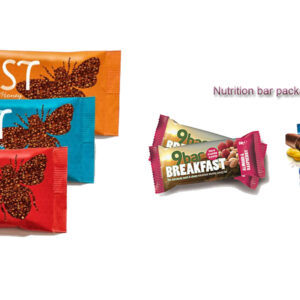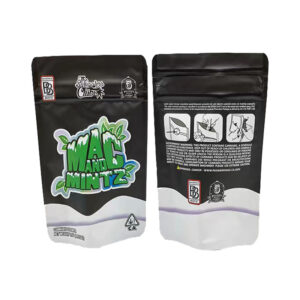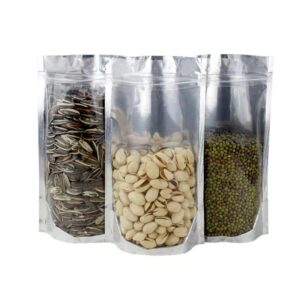Snack food bag
Snack food packaging bags are designed to protect and preserve the freshness of the product while also providing a convenient and attractive packaging solution for the consumer. Here are some common types of snack food packaging bags
Additional information
| color | custom |
|---|---|
| size | custom |
| description | snack food packaging bag |
| valve | no degassing valve |
| stock | NO |
Product details
Snack food packaging bags are designed to protect and preserve the freshness of the product while also providing a convenient and attractive packaging solution for the consumer. Here are some common types of snack food packaging bags:
- Stand-up pouches: Stand-up pouches are a popular choice for snack food packaging. They are lightweight, flexible, and can be customized with various features such as resealable zippers, tear notches, and clear windows to showcase the product. Stand-up pouches are also an eco-friendly option, as they require less material than traditional rigid packaging.
- Side-gusseted bags: Side-gusseted bags are another popular choice for snack food packaging. They are made from high-barrier materials that help to keep the product fresh and can be customized with various features such as resealable zippers and tear notches. Side-gusseted bags are also a cost-effective option, as they require less material than other types of packaging.
- Flat pouches: Flat pouches are a simple and affordable option for snack food packaging. They are made from a single sheet of material and can be customized with various features such as tear notches and clear windows. Flat pouches are also easy to store and transport, as they can be stacked flat.
- Paper bags: Paper bags are a sustainable option for snack food packaging. They are made from renewable resources and can be customized with various features such as resealable closures and clear windows. Paper bags are also lightweight and easy to transport.
Overall, snack food packaging bags should be designed to protect and preserve the freshness of the product while also providing a convenient and attractive packaging solution for the consumer. The packaging should be chosen based on the specific needs of the product, such as the desired shelf life, aroma retention, and overall appearance.
Small Snack Bags for School?
Small snack bags are a great option for school snacks as they are convenient and portion-controlled. Here are some popular types of small snack bags for school:
- Ziplock bags: Ziplock bags are a classic choice for small snack bags. They come in various sizes and are easy to open and close. Ziplock bags are also reusable, which makes them a sustainable option for school snacks.
- Paper bags: Paper bags are an eco-friendly option for small snack bags. They are made from renewable resources and can be recycled after use. Paper bags are also affordable and easy to customize with stickers or markers.
- Resealable snack bags: Resealable snack bags are designed to be used multiple times. They come in various sizes and can be customized with fun designs or characters. Resealable snack bags are also convenient for storing leftovers or other small items.
- Biodegradable bags: Biodegradable bags are a sustainable option for small snack bags. They are made from plant-based materials that break down over time, reducing the impact on the environment. Biodegradable bags are also durable and can be customized with various designs and colors.
Overall, small snack bags for school should be convenient, portion-controlled, and sustainable. The packaging should be chosen based on the specific needs of the snack, such as the desired portion size, freshness, and convenience.
How can I choose the bag for my snack food?
Choosing the right bag for your snack food is important for ensuring that your product stays fresh, looks attractive, and stands out on store shelves. Here are some factors to consider when choosing a bag for your snack food:
- Product characteristics: Consider the characteristics of your snack food, such as its size, shape, and texture. Some snacks may require a specific type of packaging to protect their shape or texture, while others may need packaging that allows for easy pouring or dispensing.
- Barrier properties: Consider the barrier properties of the packaging material, which is the ability of the material to prevent moisture, oxygen, and other elements from entering the package. Snacks that are sensitive to moisture or oxygen will require packaging materials with high barrier properties.
- Shelf life: Consider the desired shelf life of your snack food. Some snack foods may require packaging that extends their shelf life, while others may have a short shelf life and can be packaged in simpler packaging.
- Branding: Consider the branding and marketing of your snack food. Choose packaging that aligns with your brand's identity and resonates with your target audience. Customized packaging with branding elements such as logos, colors, and images can help your product stand out on store shelves.
- Environmental impact: Consider the environmental impact of your packaging. Choose packaging that is recyclable, biodegradable, or made from sustainable materials, as this can appeal to environmentally conscious consumers.
Overall, the choice of snack food packaging should be based on the specific needs of your product, such as its characteristics, shelf life, branding, and environmental impact. Work with a packaging supplier who can provide expertise and guidance on choosing the right packaging for your snack food.
How do you make small snack bags?
There are a few different methods for making small snack bags, depending on the type of bag you want to make. Here are two common methods:
- DIY Ziplock bags:
- Cut a rectangle of plastic wrap or reusable food-grade silicone wrap to the desired size of your bag.
- Fold the plastic wrap in half and press the edges together to create a seal. Leave one end open for filling.
- Fill the bag with your snack, being careful not to overfill.
- Press out any excess air and then seal the remaining edge closed.
- You can use a stapler or tape to reinforce the seal if needed.
- DIY paper bags:
- Cut a rectangle of sturdy paper (such as kraft paper or cardstock) to the desired size of your bag.
- Fold the paper in half lengthwise and press the edges together to create a crease.
- Open up the paper and fold the sides in along the crease to create gussets. The size of the gussets will determine the width of your bag.
- Fold the paper in half again along the original crease and press the edges together to create a seal.
- Fill the bag with your snack, being careful not to overfill.
- Fold the top of the bag down twice to create a closure. You can use a stapler or tape to reinforce the closure if needed.
With both methods, you can customize the size and shape of the bags to suit your needs. Be sure to choose materials that are safe for food contact and consider the environmental impact of your packaging choices.





